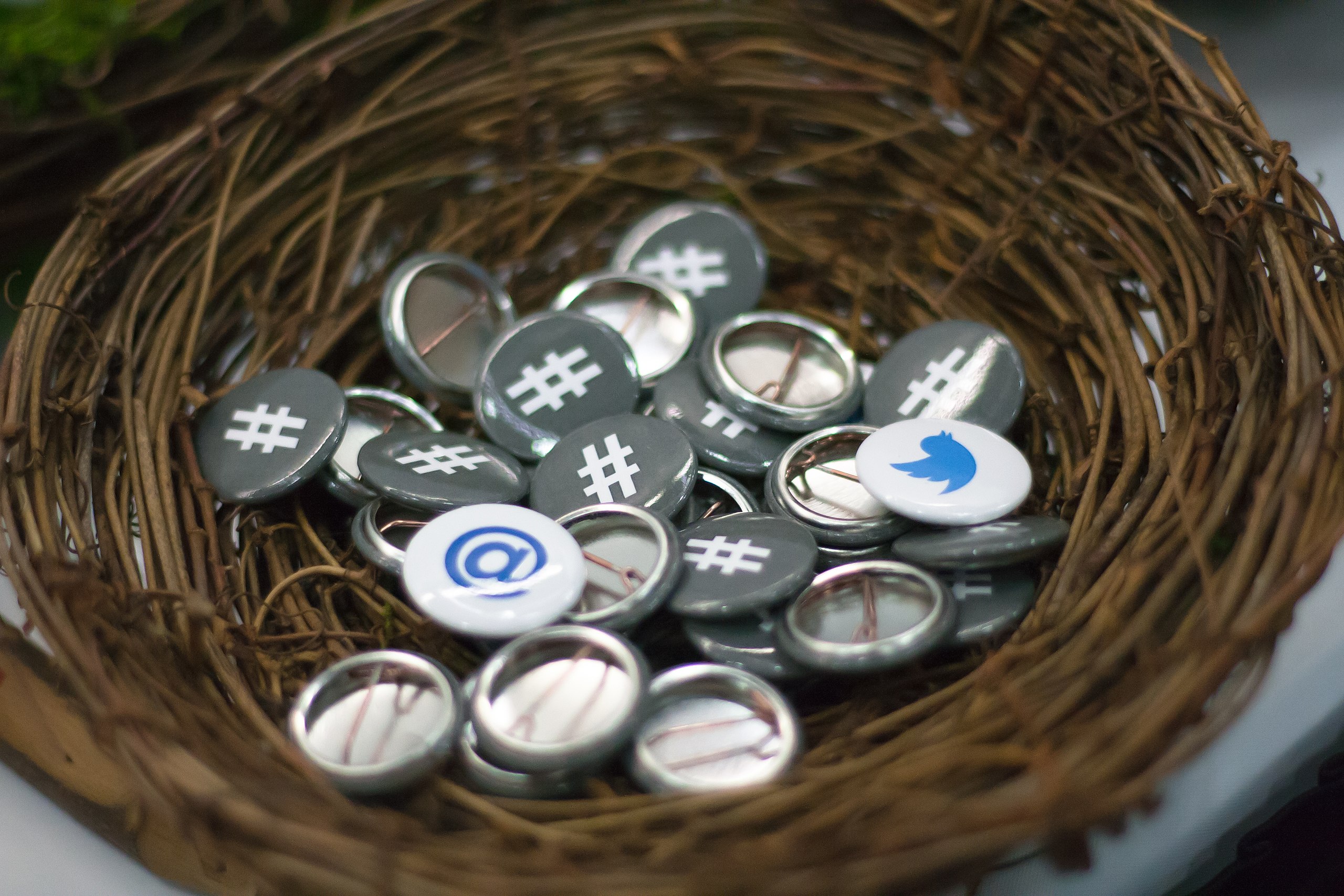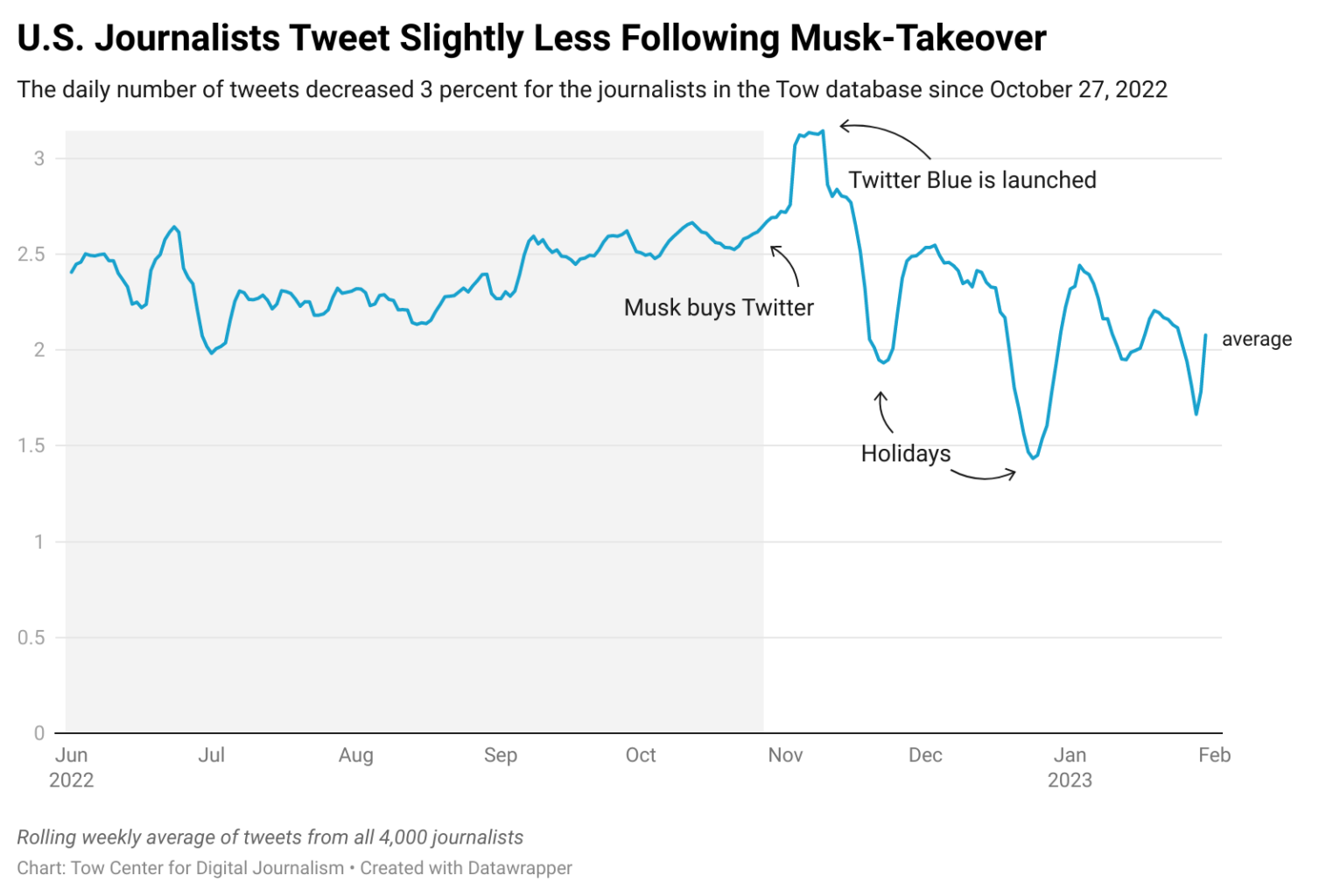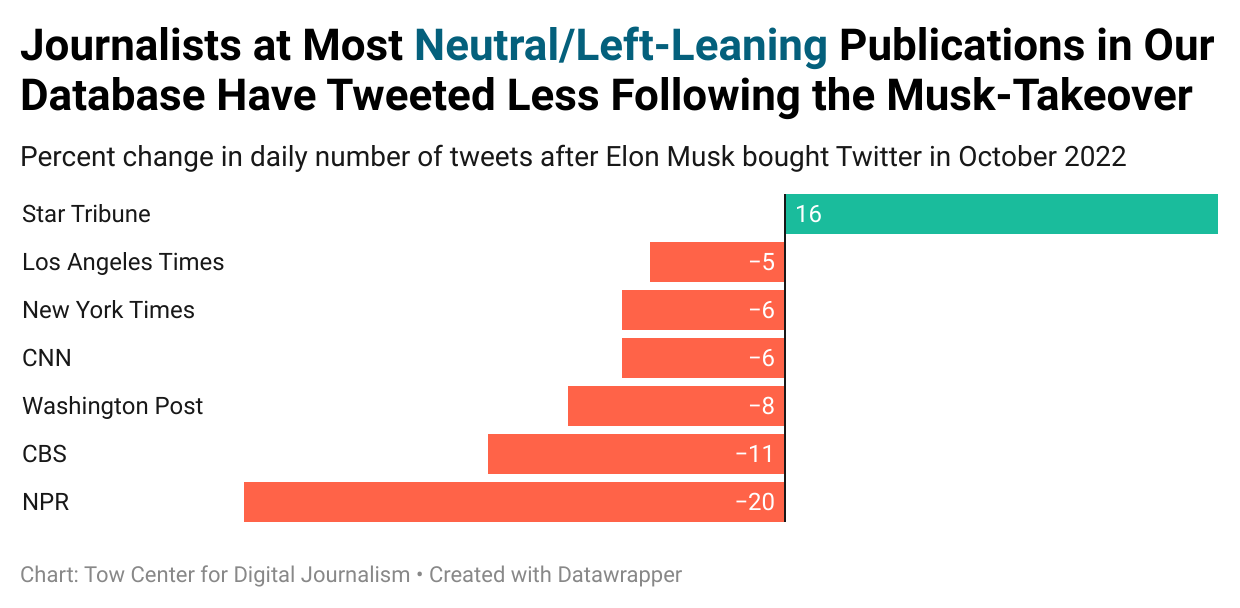Sign up for The Media Today, CJR’s daily newsletter.
New research from the Tow Center for Digital Journalism into the habits of journalists on Twitter during and after Elon Musk’s takeover of the platform reveal that despite a perceived Twitter exodus only a small handful have deactivated their accounts and the number of daily tweets has decreased just 3 percent overall. However, the change in tweeting activity is determined more by publication. Journalists in the database associated with right-leaning publications tended to tweet more following the Musk-takeover whereas journalists from left-leaning or neutral publications tended to tweet less. Tow Center research saw clear moments where the journalism community stepped back from the platform, particularly after changes to the verification system.
When Elon Musk completed his $44 billion purchase of Twitter last year, journalists around the world looked on in alarm. The relationship between the media and Musk had been simmering for years, and boiled over once he bought their favorite social media platform. Journalists “think they’re better than everyone else” Musk tweeted to his 122 million followers after getting rid of an old verification system that favored journalists, and suspending half a dozen prominent tech reporters for tweeting about an account that shared publicly available data on Musk’s personal jet.
Journalists responded by threatening to leave Twitter, seeking out other online communities such as Mastodon, Reddit, even LinkedIn. Hashtags such as #RIPTwitter and #TwitterDown trended as users wrote emotional goodbye posts lamenting the loss of networks and friendships developed on the platform. “If this is my very last tweet, I just gotta say one thing — I will never, ever, buy a Tesla,” tweeted former Vox journalist Aaron Rupar who is now an independent journalist. In an essay published in the New Yorker titled “Why I Quit Elon Musk’s Twitter,” the dean of Columbia Journalism School, Jelani Cobb, announced his decision to leave: “My sepia-tinted memories of what Twitter was—or could possibly have become—dissolved at the prospect of stuffing money in the pocket of the richest man on the planet,” Cobb wrote. His account is now private. Similarly, sports journalists Howard Bryant said he would sign off from Twitter, explaining he would “have stayed if this were a business acquisition, but it’s a political one.”
And yet, while some journalists have entirely cut ties with Twitter, a Tow Center analysis of approximately 4,000 journalists from 19 U.S. news outlets suggests that they are a small minority. The Tow Center collected historical data from June 1, 2022 to January 30, 2023 on journalists associated with multiple national and local U.S. publications such as the New York Times, Washington Post, Fox News, Daily Caller and Star Tribune. Our analysis shows that few journalists in our database have deactivated their accounts and that they have been tweeting just slightly less since Musk acquired the social media platform on October 27, 2022.
On average, journalists tweeted 3 percent less after the Musk-takeover. Activity first increased in late October and peaked on November 9 when Twitter Blue was launched for the first time and around the U.S. midterm elections. Activity then decreased slightly and dipped more drastically around Thanksgiving and the Christmas holidays.
Overall, while the journalists in our dataset tweeted fewer times, the average varied widely depending on what publication they are associated with. Journalists from right-leaning publications such as Fox News, RedState, Breitbart, Daily Caller and Federalist tweeted more on average following the Musk-takeover compared to journalists from neutral or more left-leaning publications. For instance, the average number of daily tweets for Fox News journalists increased from 3.9 to 4.4 tweets. Similarly, RedState journalists’ average daily tweets went up almost 30 percent from 12.8 to 16.3 tweets per day.
For journalists at the New York Times, CNN, NPR, Washington Post and CBS, the trend is converse; we found that, on average, the journalists in our dataset have been tweeting less in recent months. Journalists at the New York Times saw approximately a 6 percent decrease in tweets, Los Angeles Times journalists a 5 percent decrease, and NPR journalists a sweeping 20 percent decrease.
As a self-proclaimed “free speech absolutist,” Musk has made Twitter feel more welcoming to members on the right who view the Musk-takeover as a free speech victory. This could help explain why journalists at right-leaning publications have been more active compared to journalists on the left. Not only did Musk restore the accounts of numerous right-wingers such as former President Donald Trump, Jordan Peterson, and Babylon Bee, but he also laid off employees within Twitter Inc.in the trust and safety space. These employees were responsible for a myriad of issues including content moderation, tackling hate speech, and addressing misinformation. Several media personalities on the right applauded his approach. The founder of the Daily Wire, Ben Shapiro, retweeted Musk with a meme of popping champagne, and Tucker Carlson applauded Musk for making Twitter less biased towards the Democratic party.
It’s a shift away from the pre-Musk Twitter where users were generally younger, better educated, and more likely to vote Democrat than the rest of the country. Now, Republicans are gaining tens of thousands of followers while Democratic counterparts are seeing a decline. The Tow Center saw a similar trend among journalists in our analysis, with journalists from right-leaning publications on average gaining a few percent in followers and journalists from left-leaning publications losing 1 to 1.5 percent.
Among the group of approximately 4,000 journalists analyzed by the Tow Center, fewer than 10 have deactivated their account since Musk bought Twitter. According to Darren Linvill, a social media forensics researcher and Associate Professor at Clemson University, that number isn’t really surprising. Twitter is an essential tool for reporters, connecting them with other journalists and editors around the world. A Pew Research study found that around seven-in-ten U.S. journalists say that Twitter is the site they use most or second most for their job.
“There’s no motivation to permanently leave Twitter after they put years into building up their following. We’re talking about their brand here,” Linvill said. “Especially when you don’t know what the future holds. I mean, maybe Elon is gonna give it up”
In a 12-hour long poll initiated by Musk himself, 58 percent of 17 million voters said he should step down as Twitter’s CEO. Musk claimed to abide by the results, as soon as he found “someone foolish enough to take the job.” Until he does, Twitter’s future remains in a state of flux and some journalists seem to be waiting out the storm before taking drastic steps towards officially leaving.
“There’s leaving Twitter and there’s leaving Twitter,” Linvill said. “Very few people are going to do the dramatic shutting down of their accounts, but there’s probably going to be a lot of people who just kind of slowly stop using it.”
Austin-based reporter Andrea Grimes is one of those users. She created her account in 2007, just a year after Twitter was launched, and quickly became a prolific user. “I was one of the first people at the party, and one who made sure that the party had chips and dip,” she said. But when rumors started surfacing about a Musk-takeover, she prepared for her exodus by setting up accounts on other platforms such as Mastodon.
“I had my lifeboats ready,” Grimes said. “But nobody’s jumping in the lifeboat with me.”
As it turned out, not enough people were migrating off Twitter and onto the same platforms as Grimes for it to be a sufficient replacement. On Mastodon, she has a much smaller and less diverse community that didn’t let her obtain the same level of reporting. Likewise, the 40,000 followers she has accumulated over the past 15 years on Twitter weren’t gonna migrate overnight either.
“For one person to leave doesn’t do anything to Twitter. And it also doesn’t enable me as a reporter to continue to meaningfully engage with conversations that are really important to me,” Grimes said.
Users such as Grimes often feel compelled to remain on platforms where they have a large following or a large social graph because of the lack of interoperability across platforms, i.e. a network built on one platform cannot easily be migrated to another. Despite this, Musk appears to be worried about the growing discontent in parts of the Twitter user base, and at one point created a policy that banned users from adding links to their profiles on other social media networks — that policy was quickly reversed.
Since Musk took over, a subset of users have actively been looking to port their social graph elsewhere. The influx of users to Mastodon, a platform that has emerged as the natural “open” successor to Twitter, was significant (over 130,000 users a day in November) with upticks coinciding with days when Musk made controversial decisions. But the number of daily active users has been declining since its peak in December and remains just a fraction of the number of users on Twitter (1.4 versus 238 million active daily users).
Today, most major platforms are walled gardens that treat user attention as a zero-sum game, and treat other platforms as direct competition. With decisions at Twitter being left to the whims of one of the world’s richest men, there is an opportunity here for more federated, open, and distributed platforms to thrive. It’s an opportunity many journalists are willing to explore, although while keeping a foot inside the Twitter space for now. “I tweet less than I did before, but it’s still the place I’m gonna go when I want some gossip, ” Grimes said. “There simply is no substitute for it at this point.”
Methodology:
The Tow Center analyzed journalists associated with 19 U.S publications. We chose publications that are widely circulated within the U.S. and which reflected both local and national news. We also chose publications that have variation in political leanings. The outlets included in our analysis were the New York Times, Washington Post, CNN, CBS, Chicago Tribune, Newsday, Fox News, Wall Street Journal, Federalist, Daily Caller, Breitbart, LA Times, The Hill, Washington Examiner, NPR, RedState, USAToday, New York Post, and Star Tribune. Assessments of the national publications’ political leanings from our dataset were adopted from ‘Network Propaganda: Manipulation, Disinformation and Radicalization in American Politics’ by American scholars Robert Faris, Hal Roberts and Yochai Benkler. Journalists’ Twitter handles were obtained from each publication’s official Twitter page. For instance, journalists associated with Fox News can be found here and NYT journalists here. Twitter’s API was then used to pull all tweets from June 1 2022 to January 30 2023. Our dataset does not account for deleted tweets.
Data for each publication can be found here.
Previously one of our images read ‘left-leaning’ and has been updated to “Neutral/left-leaning to more accurately reflect our methodology.
Has America ever needed a media defender more than now? Help us by joining CJR today.








